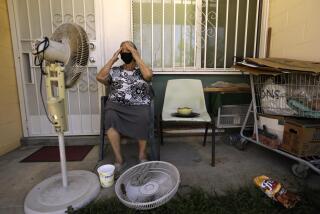HEATING : Insulate, Seal to Keep Warm Inside
- Share via
For a relatively modest sum, you can retard the loss of heat from your house and save on fuel bills. Weatherstripping, caulking and installing insulation are all projects that a do-it-yourselfer can master.
Any steps you take to reduce heat loss will also slow heat entry during the summer. If your house is air-conditioned, you may save as much on your summer bills as on your winter ones.
How Heat Is Lost The fact that warm air rises is a major cause of heat loss from many houses. Because cold air is relatively more dense and heavy than warm air, it sinks under the pull of gravity. It displaces warm air and forces it upward.
Impelled by wind outdoors and drafts indoors, cold air seeps through house cracks and openings and forces the warm air to leak through similar openings in other parts of the house. In houses with an updraft, the leaks will flow inward at the base and outward at the roof. Besides air leaks, heat can be conducted through the house shell and radiate off the surfaces of the house.
How to Reduce Heat Loss
Some heat-saving improvements, such as plugging the holes that allow air to infiltrate a house, are cheap in relation to the dollars they save. Others, such as adding or installing new insulation, cost proportionately more.
Calculate savings in dollars and then decide whether an investment is worthwhile. A contractor may recommend many improvements, only some of which may be truly economical.
Insulation, caulking and weatherstripping are generally cost-effective because they work to prevent the infiltration of cold air into your house and the escape of warm air.
The shell of your house may have cracks or gaps. Sealing them with caulk is an important way to prevent cold-air infiltration.
One of the most obvious heat-loss problems is caused by uninsulated attics and uninsulated floors above crawl spaces, as well as hollows in the walls. Because so much heat is lost upward, making sure your attic has enough insulation is a priority. If the attic is unfinished, the typical homeowner can handle it easily. Cost savings are usually high.
Windows and doors that aren’t sealed tightly are also a main cause of heat loss. Weatherstrip the top and sides of a door and put a sweep or weather-tight threshold at the bottom. Weatherstrip all sides of a typical double-hung window, including the seam where the two sashes meet.
Besides insulating and weatherstripping, you can reduce heat loss by adding storm windows and doors, shutters and thermal drapery, and using other techniques for blocking air infiltration in walls and ceilings. This last may take the most time because of the difficulty of finding all the sources and paths of infiltration.
Some Heat Loss Culprits
* Cracks in siding or gaps between roofing and chimney, siding and eaves, siding and window frames or sill and foundation.
* Holes for TV antenna cable or exterior water tap.
* Unclosed damper in fireplace chimney and unsealed spaces in window air conditioners.
* Air passages around wall switches, outlets and recessed ceiling fixtures.
* Uninsulated furnace air ducts, hot-water tank and pipes or house foundation.


